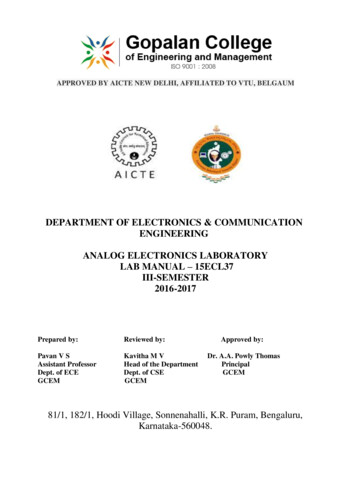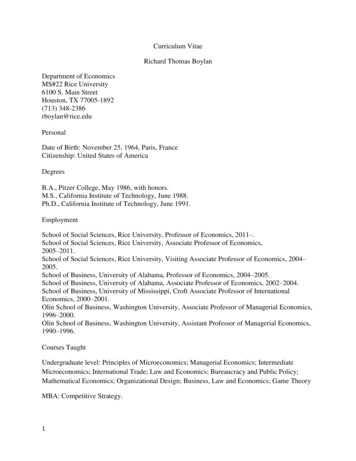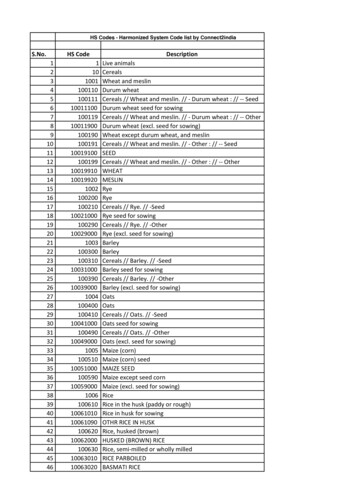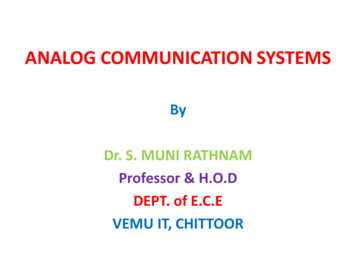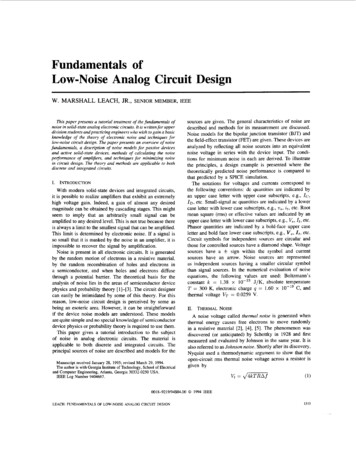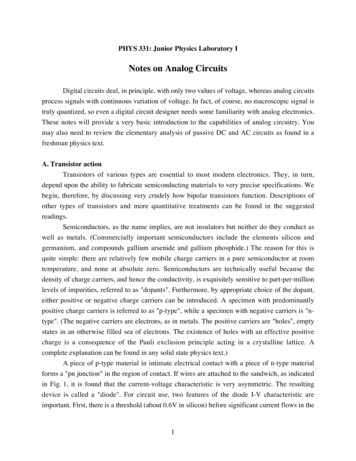
Transcription
PHYS 331: Junior Physics Laboratory INotes on Analog CircuitsDigital circuits deal, in principle, with only two values of voltage, whereas analog circuitsprocess signals with continuous variation of voltage. In fact, of course, no macroscopic signal istruly quantized, so even a digital circuit designer needs some familiarity with analog electronics.These notes will provide a very basic introduction to the capabilities of analog circuitry. Youmay also need to review the elementary analysis of passive DC and AC circuits as found in afreshman physics text.A. Transistor actionTransistors of various types are essential to most modern electronics. They, in turn,depend upon the ability to fabricate semiconducting materials to very precise specifications. Webegin, therefore, by discussing very crudely how bipolar transistors function. Descriptions ofother types of transistors and more quantitative treatments can be found in the suggestedreadings.Semiconductors, as the name implies, are not insulators but neither do they conduct aswell as metals. (Commercially important semiconductors include the elements silicon andgermanium, and compounds gallium arsenide and gallium phosphide.) The reason for this isquite simple: there are relatively few mobile charge carriers in a pure semiconductor at roomtemperature, and none at absolute zero. Semiconductors are technically useful because thedensity of charge carriers, and hence the conductivity, is exquisitely sensitive to part-per-millionlevels of impurities, referred to as "dopants". Furthermore, by appropriate choice of the dopant,either positive or negative charge carriers can be introduced. A specimen with predominantlypositive charge carriers is referred to as "p-type", while a specimen with negative carriers is "ntype". (The negative carriers are electrons, as in metals. The positive carriers are "holes", emptystates in an otherwise filled sea of electrons. The existence of holes with an effective positivecharge is a consequence of the Pauli exclusion principle acting in a crystalline lattice. Acomplete explanation can be found in any solid state physics text.)A piece of p-type material in intimate electrical contact with a piece of n-type materialforms a "pn junction" in the region of contact. If wires are attached to the sandwich, as indicatedin Fig. 1, it is found that the current-voltage characteristic is very asymmetric. The resultingdevice is called a "diode". For circuit use, two features of the diode I-V characteristic areimportant. First, there is a threshold (about 0.6V in silicon) before significant current flows in the1
p n20mA10mAI-100V-50V1Vanodecathode V1µA-2VNotescalechange!2µAFig. 1 Junction diode structure, circuit symbol and I-V characteristic.forward direction. This threshold is the "junction voltage drop" or just "junction drop". For a"forward biased" diode above threshold the current increases very rapidly with little increase inapplied voltage. Second, there is a small "leakage current" when the diode is "reverse biased" (nside positive with respect to p side). This phenomenon is usually only a minor nuisance.A more interesting device can be made by joining three layers as shown in Fig. 2 tocreate an NPN bipolar transistor. (The term "bipolar" refers to the use of both n and p-typematerial in the structure. The following description also holds for the analogous PNP transistor ifall polarities are reversed. Other designs are possible, but will not be discussed here.) Evidentlythe base-emitter and base-collector circuits will behave like diodes. The unexpected fact is that ifthe collector is made positive with respect to the emitter, then a current in the base-emitter circuitcan control the current flow across the (reverse biased) collector-base junction. For small basecurrents the relationship is linearIC hFE IB IB(1)where the current gain, h FE or , is typically 10-100. This current gain actually represents apower gain, in the sense that a low-power input signal applied to the base can cause a higherpower signal to appear in the collector circuit.CCnpnBbaseBICcollectoremitterIBIE I IBEEFig. 2 NPN junction transistor structure and circuit symbol2C
B. Gate circuitsAs a first example of transistor circuitry, consider Fig. 3, which shows the commonemitter configuration of an NPN transistor. The supply voltage VCC is taken to be positive. If Vinis zero or negative there will be no base current, hence no collector current, and the transistor issaid to be cut off. When Vin is positive and greater than the junction drop (0.6 V for silicon), basecurrent will start to flow, the collector current will increase according to Eq. 1 and VCE willdecrease. For sufficiently large IB, V CE reaches a minimum (0.1-0.2 V for silicon) and I C islimited chiefly by the load resistor R2. The transistor is now fully on, and is said to be saturated.The ability to switch between two well defined states is ideal for implementing digital logic.The common-emitter configuration is itself a possible design for a NOT circuit. Supposewe define logic 0 as a zero-volt signal and logic 1 as VCC, a positive voltage. Referring again toFig. 3, when V in 0 the transistor is cut off and Vout V CC. Conversely, if we choose R 1correctly the transistor can be driven to saturation when V in V CC. Vout is then nearly zero(actually VCE at saturation). More simply, Vout is the logical converse of Vin, as claimed.A NOR circuit can be constructed using two transistors in common emitterconfigurations, as shown in Fig. 4. A logic high applied to either input (or both) turns on Q1 orQ2, pulling the output low, which is the required function. An OR circuit could be made bydriving the NOT circuit just described with the output of the NOR.The TTL circuits used for the digital exercises also employ transistors as switches,although the circuit configuration is somewhat different to facilitate manufacture. The designrules governing fan-out and logic levels are all determined by the circuit arrangements chosen toimplement the various logic functions.V CCR2ICV outV inR1IBV CEV BEIE IB ICFig. 3 NPN transistor in common-emitter configuration3
V CCV CCORNORAQ1Q3Q2BFig. 4 Two-transistor NOR gate and conversion to OR.Collector Current, I C (mA)C. Single-stage amplifiersThe common emitter configuration can be modified to produce an output signal that islinearly proportional to the input, a function known as amplification. The trick is to supply aconstant base current, called a bias current, so that the transistor is partially turned on. The signalcurrent is then superimposed on the constant bias current. The resulting collector current willhave a DC component, proportional to the bias current, plus a varying component proportional tothe signal current. Figure 5 presents the same argument graphically, and Fig. 6 shows a circuit432100103020Base Current, I (µA)40BFig. 5 Plot of collector current vs base current showing effect of bias and signal inputs. Thedashed line indicates the bias current input and resulting collector current. Addition of a varyingcomponent causes the collector current to follow within the limits shown.4
V CCRCR1CVoutVinRER2Fig. 6. Biased NPN common-emitter amplifier. A capacitor is used to couple in the AC signal sothat the signal source cannot affect the bias current. The same circuit works for a PNP transistorif all polarities are reversed.implementation. Since the plot is not a straight line there will always be some distortion in theoutput signal, and signals large enough to drive the transistor into cut-off or saturation will belimited or 'clipped'.The output voltage of the common emitter amplifier can be substantially larger than theinput voltage. With no external signal, some amount of collector current flows, resulting in avoltage drop across the collector resistor which sets the output voltage between VCC and ground.A small positive signal input will cause additional base current to flow, which causes a muchlarger increase in the collector current, increasing the voltage drop across the collector resistorand lowering the output voltage. A small negative signal would decrease the base current,thereby increasing the output voltage. The output voltage is therefore an inverted and amplifiedreplica of the input, offset by a DC component due to the bias current. The DC component can beblocked by another capacitor, leaving only the desired signal. A detailed analysis shows that thegain is determined by hFE and by the effective resistances at input and output.The emitter resistor RE shown in Fig. 6 is not actually essential for circuit function, but itdoes serve a very useful purpose. The flow of collector current heats the junction because ofinevitable losses. The current gain hFE increases at higher temperatures, resulting in still morecollector current for the same bias current, further increasing the temperature. In the absence ofan emitter resistor, this succession of events can destroy the device, a phenomenon known asthermal runaway. At best, it will shift the operating point toward saturation and may make thecircuit inoperative. An emitter resistor reduces the tendency for thermal runaway by reducing the5
V CCVinVoutREFig. 7 The emitter-follower circuit.voltage from base to emitter as the collector current increases. The decrease in VBE decreases thebase current, partially compensating for the increased hFE and thereby stabilizing the circuit. Thisis an example of negative feedback, which we will see again later. Practically, an RE muchsmaller than RC is usually sufficient for stability.Sometimes one wants to transfer substantial power to a low resistance load. If the signalsource cannot supply the power, the emitter follower circuit in Fig. 7 is useful. A small currentfrom the signal source, applied to the base, can cause a large amount of current to flow throughthe emitter resistor or a load connected in parallel with it. Note that this amplifier does not invert:An increase in base voltage causes more collector current to flow, increasing the voltage at theemitter. It can be shown that the output voltage is only equal to the input voltage, minus the dropin the base-emitter diode, so there is no voltage gain. The circuit provides power gain, however,because there is a much larger current at the output than the input, and power is the product ofcurrent and voltage.As drawn, the emitter follower can connect the load to the positive supply, but it cannotproduce negative output voltages. Like the common emitter amplifier, the follower can be biasedto amplify AC signals, but that leads to a steady current flow in the emitter resistor. If the circuitis intended for high power this implies large dissipation in the emitter resistor even in theabsence of a signal. A much more interesting possibility is shown in Fig. 8. One transistor isNPN and the other PNP, connected between positive and negative supplies so that Q1 conductson positive input swings and Q2 on negative inputs. With no input there is no collector currentand hence no dissipation at all in the absence of a signal. The emitter resistor is shared by Q1 andQ2, and is usually the load to be driven rather than a separate circuit element. This circuit iscalled a push-pull emitter follower, or a complementary pair, and is widely used as the outputstage of relatively high power amplifiers.6
V CCQ1VinQR load2-V EEFig. 8 A simple push-pull circuit, without bias.Two failings of the push-pull follower are thermal runaway and crossover distortion. Asin the common emitter amplifier, thermal runaway can be avoided by a small emitter resistor,typically an ohm or two, in each emitter lead. Crossover distortion occurs because the inputsignal must be large enough to turn on the base-emitter diode before the transistor will conduct.The circuit does not, therefore, produce an output until the input is bigger than about 0.6V,resulting in a distorted waveform. One cure is to bias the transistors so that they are on the verge V CCRQ1REVinRQER load2R-V EEFig. 9 A push-pull circuit with bias and runaway protection.7
of conduction without a signal. This is shown in Fig. 9, where diodes are used to set the basevoltage exactly one diode drop above or below zero. An alternative is to use feedback, as we willdemonstrate later.The magnitude of voltage or power gain available from a single stage of amplification isobviously limited, so most practical amplifiers consist of several coupled stages. Furtherrefinements are often added to improve characteristics such as frequency response or distortionfor particular applications. Such complex devices are usually purchased, rather than beingdesigned by an experimentalist, so they will not be considered here.D. OscillatorsAn oscillator circuit converts DC electrical energy into a periodic signal. One way toaccomplish this is to feed part of the output of an amplifier back to the input. If, for somefrequency, the feedback is in phase at the input, and if the power gain around the loop is greaterthan one, the output will be a self-sustaining oscillation at the favored frequency. This can occurdeliberately, as in the circuits below, or by accident.Fig. 10 shows two classic designs, implemented with an NPN transistor as the gainelement. The Colpitts circuit is based on a biased emitter follower stage. Part of the output goesto the base through the LC circuit, whose resonant frequency determines the oscillationfrequency. Coupling capacitor CC is included to block the DC path through the feedback circuit,thereby maintaining the desired bias level. The Hartley circuit is based on a common emitterV CCV CCRCRBVoutRBCLCCRBLCFVoutCCCBRBRERE(b)(a)Fig 10. Single-transistor oscillator circuits: (a) Colpitts, (b) Hartley8
amplifier, with an LC circuit replacing the collector resistor and with a transformer-coupledoutput. Without the feedback capacitor CF this circuit would have a frequency-dependent gain,maximum at the LC resonant frequency. By coupling some of the output into the emitter circuit,CF causes the base-emitter voltage to vary slightly, modulating the base current and sustainingthe oscillation at the LC resonant frequency. CB holds the bias voltage steady so that the feedbackis not cancelled by a changing voltage drop across RB.Any amplifier circuit may become an oscillator if stray inductance or capacitance,perhaps within the transistor structure, in a breadboard or in a power supply, provides positivefeedback at any frequency for which the gain is sufficiently large. The cure is to change thelayout of the circuit so that unintended capacitances between input and output are reduced,decrease the inductance of power supplies or decouple them with a local capacitor, and decreasethe bandwidth of the amplifier as much as possible. At high frequencies it may be necessary todivide the necessary gain across several stages, each of which is carefully isolated from adjacentstages.E. Operational AmplifiersOperational amplifiers are multi-stage differential amplifiers characterized by high gain,high input impedance and wide bandwidth. The ideal op-amp has infinite differential gain, nocommon mode gain (a signal applied to both inputs is not amplified), infinite input impedance (itdraws no current from the input signal), zero output impedance (output voltage is unaffected byload impedance), and the output can change instantaneously to the required value. Op-amps areoften used as building blocks to create functions needed by specific experiments in much thesame way that packaged gate circuits are used to synthesize digital logic. These low cost,commercially available devices come remarkably close to the ideal, so we assume perfectperformance and note the effect of real limitations qualitatively.General purpose op-amps have two inputs, labeled and -, and a single output. When the terminal is positive with respect to the - terminal, the output voltage goes positive, whilereversing the input polarity reverses the output polarity. Because of the high gain, a very smalldifference in voltage at the input terminals will drive the amplifier to full output. Op-amps are,therefore, almost always used with external feedback to obtain the desired function. The effect ofan ideal amplifier on the feedback circuit can be understood by applying two rules: (1) Theoutput changes in such a was as to make the voltage difference between the inputs zero; (2) Theinputs draw no current.The circuit of Fig. 11(a) provides a simple example for analysis. Applying the secondrule, we find and Ii If. Using Ohm's law to get the individual currents then gives the relation9
RfViRiIiV i1If V i2VoV i3(a)R i1R i2R i3Rf Vo(b)Fig. 11 (a) A simple inverting amplifier and (b) a multi-input inverter or adder.Ii Vi V V Vo IfRiRf(2)The first rule requires V- 0, so this simplifies toVo RfRiVi(3)which tells us that the gain of the circuit is determined by the resistances and not by theamplifier, whose gain may vary from unit to unit. The minus sign indicates that the output isinverted relative to the input.The same analysis applied to the circuit of Fig. 11(b) yieldsVo RfRi1Vi1 RfRi2Vi2 RfRi3Vi3(4)so it constitutes a weighted inverting adder. The advantage of this circuit over a passive resistivecombiner is that there is no interaction among the input signals. Each input sees a resistorconnected to a virtual ground point at zero volts, regardless of the other inputs.It is also possible to construct a non-inverting circuit, as shown in Fig. 12(a). The voltageat the inverting terminal is determined by the R1, R2 voltage dividerV R2VR1 R2 o(5)Rule 2 requires that the amplifier adjust Vo until V- Vi, so10
Vi -R2 -ViVoVoR1(a)(b)Fig 12 (a) A non-inverting amplifier or follower with gain. (b) A unity-gain follower. R Vo 1 1 Vi R2 (6)Again, the voltage gain is determined by a resistance ratio, but there is no inversion. Thisarrangement can be generalized to several inputs, as with the inverter. Alternatively, if we let R1become very small and R2 become very large, we arrive at the circuit of Fig. 12(b). This is calleda follower, because the output voltage 'follows' the input voltage. Followers are used when it isnecessary to isolate a signal source from a load or to obtain more power output than the signalsource can provide.A combination adder/subtractor, usually called a differential voltage amplifier, is shownin Fig. 13. Applying the rules, one can show that the output is proportional to the differencebetween the voltages at the inputs:Vo R2(Vi2 Vi1 )R1(7)This is useful in situations where the signal source is 'floating', that is when both terminals are atsome potential above ground and the desired signal is their voltage difference. A disadvantage ofR2V i1V i2R1 VoR1R2Fig. 13 One implementation of a differential amplifier.11
RfCfCfRiRiVi ViVo Vo(b)(a)Fig. 14 (a) A pure integrator or low-pass filter. (b) An averager and low-pass filter.this particular circuit is that it becomes inaccurate if the resistors are not exactly equal asassumed. Better and more complex designs avoid the need for precise resistor matching, and areavailable as combined units called instrumentation amplifiers.There are even more interesting possibilities if we allow frequency-dependent feedback.Consider the circuit of Fig. 14(a). The analysis leading to Eq. (3) is applicable, provided wesubstitute the complex impedance of the feedback capacitor for the simple resistance term. Theresult isVo jV Ri C f i(8)where j is the square root of -1. (This usage is conventional in electrical engineering, to avoidconfusion with currents.) Evidently the output has a 90 phase shift and the gain varies inverselywith the frequency. The circuit is therefore a filter that passes low frequencies and attenuateshigh frequencies.A more physical analysis provides a different viewpoint on the same circuit. Start withthe fundamental equations for a capacitorCV QI dQdV Cdtdt(9)and then invoke the second rule to equate the input current to the feedback currentVidV C f oRidt(10)This equation can be integrated to yield12
1Ri C ft 0 Vidt Vo(11)which tells us that we have built an integrator. Integrators are not common, but they are used asramp generators in sweep circuits and in analog to digital converters.Although the integrator is a low-pass filter, the infinite gain at DC means that any smalloffset will accumulate until the amplifier saturates. This problem can be avoided by adding aresistor in parallel as in Fig. 14(b). Using complex impedances again, one can show thatVo Rf11 2 R 2f C2f[1/ 2Ri](12)ViAt high frequencies the response falls like 1/ , just as for the integrator, but at low frequenciesthe gain is limited to R f /Ri, so this arrangement is more practical as a filter. Many other filtercircuits with advantageous characteristics for particular applications are possible, but we will notconsider them here.The circuit in Fig. 15(a) is useful with transducers that produce a current, rather than avoltage output. When the photodiode is biased as shown the reverse current is directlyproportional to the intensity of the light absorbed near the PN junction. Following the rules, theamplifier adjusts Vo so that all the current flows through Rf ,V- 0, and the output voltage isVo R f Ii(13)Logically the 'gain' of this current to voltage converter would be expressed in ohms, but it ismore common and convenient to use volts/amp. The simple resistor of Fig. 15(b) is also acurrent-voltage converter, but here the voltage drop across the transducer decreases as the current V CC V CCRfIi Vo(a)VoR(b)Fig. 15 Two approaches to current-voltage conversion.13
increases. This may lead to non-linearities which are avoided in the op-amp circuit because thedevice always sees a virtual ground at the op-amp input.A typical integrated-circuit op-amp can produce output currents up to a few milliampsand output voltages to nearly the supply voltages. If this is not sufficient, one can add circuitry toincrease the output capability. The push-pull booster shown in Fig. 16 is a typical solution. Notethat the feedback for the inverter is taken around the booster, not just the op-amp. This is done toremove the cross-over distortion that would otherwise occur with an unbiased complementarypair.RfViRi V CC Vo-V EEFig. 16 Op-amp inverter with power booster on the output.14
Notes on Analog Circuits Digital circuits deal, in principle, with only two values of voltage, whereas analog circuits process signals with continuous variation of voltage. In fact, of course, no macroscopic signal is truly quantized, so even a digital circuit designer needs s

